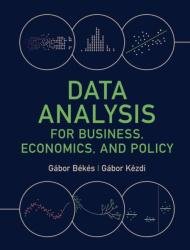Data Analysis for Business, Economics, and Policy
- Добавил: literator
- Дата: 13-11-2021, 21:02
- Комментариев: 0
 Название: Data Analysis for Business, Economics, and Policy
Название: Data Analysis for Business, Economics, and PolicyАвтор: Gabor Bekes, Gabor Kezdi
Издательство: Cambridge University Press
Год: 2021
Страниц: 742
Язык: английский
Формат: pdf (true)
Размер: 10.2 MB
This textbook provides future data analysts with the tools, methods, and skills needed to answer data-focused, real-life questions; to carry out data analysis; and to visualize and interpret results to support better decisions in business, economics, and public policy. Data wrangling and exploration, regression analysis, Machine Learning, and causal analysis are comprehensively covered, as well as when, why, and how the methods work, and how they relate to each other. As the most effective way to communicate data analysis, running case studies play a central role in this textbook. Each case starts with an industry-relevant question and answers it by using real-world data and applying the tools and methods covered in the textbook. Learning is then consolidated by 360 practice questions and 120 data exercises. Extensive online resources, including raw and cleaned data and codes for all analysis in Stata, R, and Python, can be found at site.
Data analysis is a process. It starts with formulating a question and collecting appropriate data, or assessing whether the available data can help answer the question. Then comes cleaning and organizing the data, tedious but essential tasks that affect the results of the analysis as much as any other step in the process. Exploratory data analysis gives context to the eventual results and helps deciding the details of the analytical method to be applied. The main analysis consists of choosing and implementing the method to answer the question, with potential robustness checks. Along the way, correct interpretation and effective presentation of the results are crucial. Carefully crafted data visualization help summarize our findings and convey key messages. The final task is to answer the original question, with potential qualifications and directions for future inquiries.
Our textbook equips future data analysts with the most important tools, methods, and skills they need through the entire process of data analysis to answer data focused, real-life questions. We cover all the fundamental methods that help along the process of data analysis. The textbook is divided into four parts covering data wrangling and exploration, regression analysis, prediction with Machine Learning, and causal analysis. We explain when, why, and how the various methods work, and how they are related to each other.
Our approach has a different focus compared to the typical textbooks in econometrics and data science. They are often excellent in teaching many econometric and machine learning methods. But they don’t give much guidance about how to carry out an actual data analysis project from beginning to end. Instead, students have to learn all of that when they work through individual projects, guided by their teachers, advisors, and peers – but not their textbooks.
To cover all of the steps that are necessary to carry out an actual data analysis project, we built a large number of fully developed case studies. While each case study focuses on the particular method discussed in the chapter, they illustrate all elements of the process from question through analysis to conclusion. We facilitate individual work by sharing all data and code in Stata, R, and
Python.
Who is this book for?
This textbook was written to be a complete course in data analysis. It introduces and discusses the most important concepts and methods in exploratory data analysis, regression analysis, Machine Learning and causal analysis. Thus, readers don’t need to have a background in those areas.
Скачать Data Analysis for Business, Economics, and Policy
[related-news] [/related-news]
Внимание
Уважаемый посетитель, Вы зашли на сайт как незарегистрированный пользователь.
Мы рекомендуем Вам зарегистрироваться либо войти на сайт под своим именем.
Уважаемый посетитель, Вы зашли на сайт как незарегистрированный пользователь.
Мы рекомендуем Вам зарегистрироваться либо войти на сайт под своим именем.
